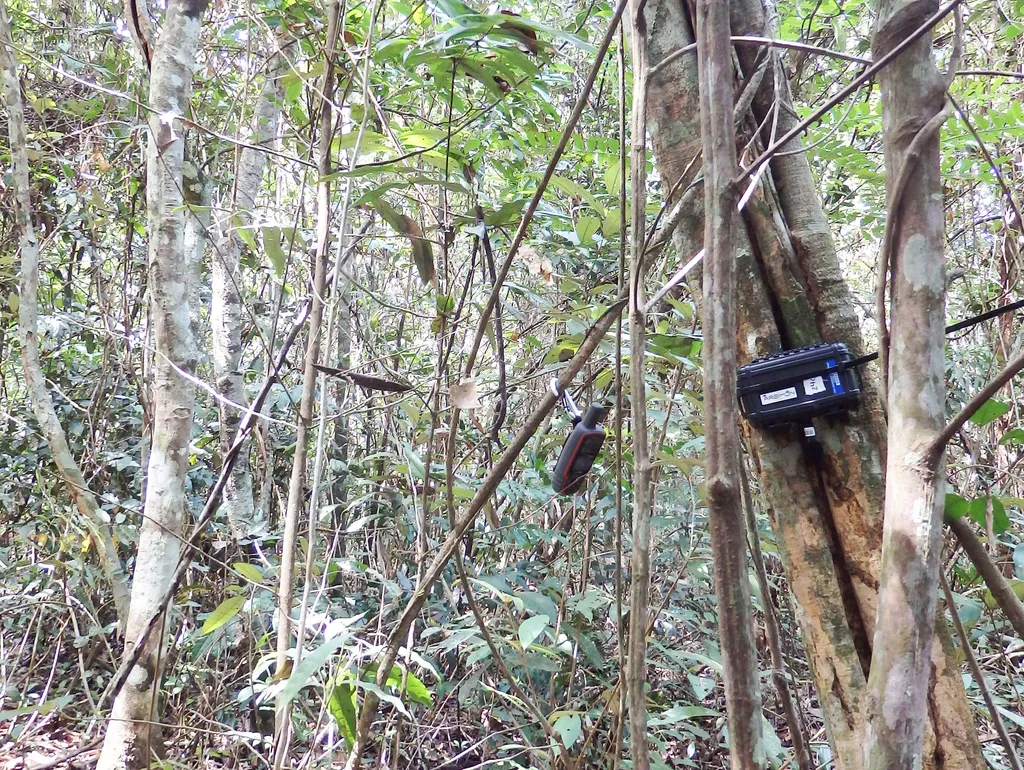- July 18, 2022
- By Georgia Jiang
Imagine being able to measure the health of an ecosystem simply by listening to a chorus of animal calls. Like the heartbeat of a habitat, movements in these natural symphonies can help scientists monitor important shifts in an animal community, such as population expansion or decline.
University of Maryland researchers used this innovative concept—called “ecoacoustics”—to make significant discoveries about biodiversity and degradation in the Amazon. They recently published their findings in the Proceedings of the National Academy of Sciences.
“Every chirp, hiss and growl represents a species that’s present in the area, so they’re a great indicator of biodiversity. Generally, the more diverse animal ‘conversations’ in a given forest area, the more animal biodiversity supported by that habitat,” said lead author Danielle Rappaport Ph.D. ’20, who studied geographical sciences. Other UMD scientists on the research team included Distinguished University Professor of Biology Bill Fagan, geographical sciences Professor Ralph Dubayah, geographical sciences Adjunct Assistant Professor Douglas Morton, chief of the Biospheric Sciences Laboratory at NASA’s Goddard Space Flight Center, and Anshuman Swain Ph.D. ’22.

To collect the necessary sounds, Rappaport and her team installed a remote ground network of recording devices called an ARBIMON (or Automated Remote Biodiversity Monitoring Network) along 39 sites previously impacted by land-clearing fires or logging operations. After compiling thousands of hours of audio footage at these sites, the team analyzed the variety and volume of animal noises at each of them. The group then linked distinct compositions of “animal orchestras” to burning or logging events that occurred between 1984 to 2017, tracking how the affected communities evolved over time.
According to Swain, who earned his doctorate in biological sciences, this sound-based approach helps address limitations of previous research on biodiversity in the Amazon.
“Traditionally, scientists had to conduct extensive field surveys in order to gauge biodiversity and overall degradation. The process was extremely time-consuming, expensive and reliant on having many different experts on site,” Swain said. “On the other hand, listening to soundscapes is far simpler, less resource intensive and fairly scalable; all you need to start is a sound recording device.”
The low-cost, yet effective nature of ecoacoustics allowed the UMD team to focus on research subjects that were relatively overlooked by earlier studies. This was particularly true for insects, because they are often too difficult to identify or even see during field surveys. The recording devices also captured 24-hour cycles of data, allowing the team to explore animal activity beyond daytime hours and forgo the visibility restrictions that limit more traditional survey methods.
This revealed that insects and their nocturnal acoustic activity were the most accurate markers of biodiversity change from environmental degradation—perhaps due to insects’ extreme sensitivity to changes in forest structure and microclimate. One of the biggest signs of biodiversity loss was the increasing homogeneity of insect sounds in forests after fire and logging. Acoustic spaces previously occupied by many varieties of species now host only a few, and the effect is exacerbated when it comes to multiple fires.
Fire events have broader consequences than just shrinking insect populations, Swain warned.
“If one fire is bad, then two fires make it even worse. Damage from multiple fires forcefully reorganizes the community,” Swain said. “After four to five consecutive fires, the community can eventually ‘recover,’ but the population will be completely changed from its original form. The insects and the animals connected to them have gone and won’t ever come back.”
The research team’s conclusions provide a sobering reminder that ongoing human activities, primarily logging or burning for land development, have profound and long-term impacts on Amazonian ecosystems. With population expansions and increased demand for natural resources, it seems inevitable that humans will continue their encroachment. However, the researchers hope a balance between human need and conservation can be reached.
“We were surprised to discover that there isn’t a strong relationship between acoustic biodiversity and biomass–the number of trees and amount of vegetation aboveground,” Swain explained. “It’s a bit counterintuitive, but it also helps us get a better sense of how forests might be able to recover under certain conditions. For example, logging decreases biomass, but it doesn’t have the same devastating long-term effect on an acoustic community as multiple land-clearing fires.”
The team believes that its research can provide additional insight into biodiversity and how complicated factors like climate change and human activity may affect it.
“Having an accurate gauge of the Amazon’s current degradation levels and capacity for ecological resilience is crucial to saving it,” said Rappaport, who co-founded the Amazon Investor Coalition to continue the work she started on this project.
